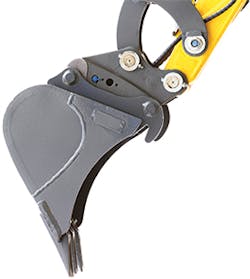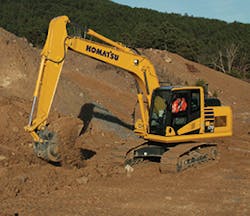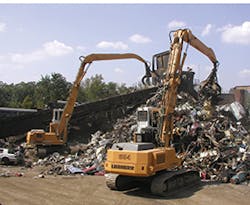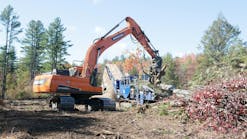Excavators come in all sizes and configurations. How are we supposed to know which one will be best for us? Other than the opinions which other, experienced contractors give you, the best information probably comes from the manufacturers. Let me start with some wise, unprejudiced words from one manufacturer. “Before purchasing a compact excavator, the single most important factor an equipment manager or user needs to consider is the intended application(s),” advises Nathan Ryan, product manager for wheel loaders and excavators at the Manitou Group (which includes Gehl). This advice was repeated by many people for all kinds of projects and equipment. “Several types of excavation tools are available in the marketplace. For minimal use applications, a backhoe skid-steer attachment may meet your needs. Alternatively, backhoe loaders offer more functionality and capacity while still minimizing trailer space. Of course, if you expect moderate to heavy use and already own a skid-steer, track loader, or just want to maximize the productivity of your investment, adding a compact excavator is the obvious choice.”
Ryan continues by saying that, if you’ve made the decision to purchase an excavator, the first consideration must be size. “Choosing a much larger excavator will require larger trailers and trucks for transport and may also result in underutilization,” says Ryan. “If you are able to finish your excavation job in an hour and the machine sits idle for the rest of the day, then you’re not maximizing the return on your investment and likely purchased too large an excavator. On the other hand, size will dictate your dig depth and digging power, so purchasing too small an excavator will limit your potential applications. The 3- to 4-metric-ton size class for compact excavators like those from Gehl is most popular in the US, primarily because of ease of transport and functionality, but another driving force behind this size class is price point. A typical list price for an excavator in this size class is roughly $48,000 to $52,000, which can be combined with a midsize skid-steer and still fall well below the price tag of a backhoe loader.”
“Once you’ve narrowed down your size selection, it’s time to consider brand,” notes Ryan. “If you have a dealer you are comfortable working with, or have other compact equipment of a given brand, that’s a great place to start. Compare other brands with dealers in your area, even if it only results in you appreciating your customary brand even more. At least you’ll know what else is available in the market place. Brand should outweigh price in your purchasing decision, due to the factors of resale value, parts availability, reliability, and customer support. An additional $1,000 at the time of purchase is minimal compared to the cost of renting a machine while yours is down and waiting for parts. When the selection has been narrowed down to a couple of brands and a few models, it’s time to start looking at the specs.”
Dig depth can be the most critical specification to consider, but dump height will dictate what size truck or trailer you can dump your spoils into. Breakout forces, both arm and bucket, not one or the other, will determine your digging performance. “I highly recommend demos before purchasing any equipment, to get a true feel for performance,” observes Ryan. Finally, compare features between the models. Some feature differences may be creature comforts while others will limit your applications. For instance, conventional tail excavators may offer more stability and possibly higher breakout forces, but can’t efficiently be used along the sides of buildings or in tight spaces. Zero tail units, on the other hand, can dig worry-free while adjacent to buildings and perform the same tasks as conventional units with minimal degradation of comfort. Other features, such as direct-to-tank return flow for hammers and proportional auxiliary controls for thumbs, expand the potential applications and increase productivity. The bottom line is that buying an excavator requires thorough research and demos. Users shouldn’t make any assumptions about brands or size classes until they have gotten some seat-time in a few different models so they can fully weigh their options before investment.
The Importance of Hydraulics and Maintenance
The size of the excavator you choose is obviously important, but there is more to an excavator than its size. What attachments can it handle? Excavators can help increase productivity on any project requiring craning utilities into place overhead or burying underground, digging, compacting, and backfilling trenches, breaking up concrete, and digging postholes with the appropriate attachment. “No matter what attachment an operator is using, the key to productivity is to make sure the machine’s hydraulic flow is matched to the attachment, and that it is easy for operators to change out and operate the attachment,” advises Jamie Wright, product manager at Terex Corp. America. “For instance, quick-coupler systems make it fast and easy to change attachments, and auxiliary hydraulics offer flexibility in adding attachments. Terex excavators are engineered with an auxiliary hydraulic circuit that has an open return and are plumbed out to the dipper stick. This provides customers with immediate dual function capability [i.e., no switching back and forth]. Terex excavators use load-sensing hydraulics to provide excellent multitasking capabilities for the boom, dipper, and attachment.”
“A modern hydraulic system will allow the operator to run boom, stick, and swing functions in a precise, smooth, and efficient manner,” explains Wright. On today’s popular compact excavators, the hydraulic system gives the operator powerful breakout and lift forces to complete tough jobs with low effort and smooth joystick control movement. “For the most part, the basics of a hydraulic system, whether on an excavator, tractor loader backhoe, or skid-steer loader, are the same. Hydraulic machines have the same components: the engine, hydraulic pump, hydraulic valve, hydraulic motors, and hydraulic cylinders. For excavators, to run multiple functions simultaneously (such as curling the bucket, raising the boom, and swinging the upper carriage) hydraulic motors and multiple cylinders are needed.
Load-independent flow division has hydraulic oil supplied to the motors and cylinders, per operator commands, without regard to what other functions are being operated. This allows the operator to multitask without losing power because the oil is able to flow to multiple functions simultaneously. It is an invaluable asset in an excavator’s internal workings. Terex uses a load-sensing system in its compact excavators that permits the axial piston pump to respond to changes in the load without overloading the engine. First of all, this saves fuel! It also extends the life of the machine’s components. With a load-sensing system, the pump senses the operator’s commands and directs the flow of oil to that chosen function, without stopping the other functions.
Here’s some excellent advice to consider. “Ease of maintenance is critical, as contractors (or their dealers) will spend a lot of time greasing joints, changing filters, and checking fluids throughout the life of that machine,” we are reminded by Brad Stemper, solutions marketing manager for Case Construction Equipment. “Look for machines that simplify maintenance by positioning daily service points in easy-to-reach areas. Ultimately, this will help you minimize downtime related to equipment upkeep.”
“It’s also important to have a good understanding of total cost of ownership when you go out to buy a machine,” adds Stemper. “The purchase price is often the baseline, but each dealer and manufacturer has different incentives and programs aimed at removing as much of that variability in equipment ownership costs as possible. This includes warranties and dealer service contracts aimed at allowing contractors to buy equipment and to budget for it properly, knowing those equipment costs won’t change within a certain amount of time. Similarly, telematics subscriptions can be bundled with these programs to provide contractors with yet another tool to help keep equipment costs down, monitor equipment maintenance and productivity, and provide a better overall understanding of equipment utilization.”
Komatsu’s PC170-10 offers optional
counterweights meeting different job and transport requirements.
The Impact of Compacts
It’s not many years ago (some of you were still in school) that an excavator was perceived as a large piece of construction equipment; the development of compact excavators changed that. There are certainly enough models of compact excavators to make the choice of an excavator a whole new challenge. “One of the first questions to answer is whether you need a compact excavator,” suggests Tom Connor, excavator product specialist for Bobcat Co. “If you frequently rent a compact excavator or subcontract work done by compact excavators, then you can probably justify adding one to your equipment fleet. Generally, construction contractors will find more uses than anticipated for the machine once it’s in their possession.” It’s important to assess maximum utilization of the machine. “Does the manufacturer offer attachments, and does the dealer stock them?” asks Connor. “Does the machine have an easy-to-use attachment mounting system? Is the machine designed to accommodate a hydraulic clamp?”
It isn’t only the sheer size of an excavator that matters. Often it is the way the machine is operated, the way the operator must guide it, and the way it gets to its work site that matters. With many construction jobs done on property where access is difficult-and that can be at a residential project or downtown with narrow streets and alleys-the configuration can be significant. Some manufacturers (like Bobcat in the M-Series 324 and 418) offer retractable undercarriages, which allow the operator to retract the undercarriage, go through a gate or fence, and then expand the undercarriage when working. Production is a key word, and the owner of an excavator wants as much as possible from the model he or she chooses. Some smaller excavators have power that would have been unimaginable a few years ago, with breakout forces and digging depths traditionally associated with larger machines, and even long-arm or extendable arm options.
“If lifting 1,000-pound spools will be a frequent, recurring task for the excavator, then one needs to select a machine that will accomplish this comfortably,” notes Connor. “If minimum cover is 8 feet, one should be looking at a machine capable of digging 10 to 12 feet to achieve decent production.”
The Big Excavators
Size will always be a sensible consideration. If you have a large excavation project, you will probably need a large excavator if you wish your job to be profitable. Again, however, check to find out the advantages for your project of one excavator over another. The US Open Golf Championship is in Pinehurst, NC, this year. That will mean thousands of visitors and good roads for them to travel to reach their enjoyable destination. The S.T. Wooten Corp. is the premier contractor for this big task: expand Highway NC-211 rapidly to accommodate the golf fans. The overall project includes widening the road to a multilane highway with curbs, gutters, and sidewalks, as well as installing traffic signals and signs. What kind of excavator do you want for such a major project? Wooten chose the Caterpillar 336 Hybrid excavator. The operator describes the excavator as “powerful in its breakout force, comfortable, and fuel efficient.” This excavator is large; it has an operating weight of 82,000 pounds. Its maximum drawbar pull is 66,319 pounds. The maximum flow of the hydraulic system is 150 gallons per minute, with maximum flow of the swing system 73 gallons per minute. The bore of the boom cylinder is 5.9 inches, the stroke 56.7 inches. The bore of the stick cylinder is 6.7 inches, the stroke 68.4 inches. But it burns only 5 gallons per hour on the site to prepare for the US Open, and it strikes the workers there as “very quiet.” A quiet excavator? The noise for the operator station is measured at only 69 decibels (which is lower than some household vacuum cleaners and blow dryers).
“A hybrid is independent of any particular technology,” advises Ken Gray, global product manager for large hydraulic excavators for Caterpillar’s Excavation Division. “It doesn’t have to be electric. There are many ways to store and reuse energy, including our patented hydraulic hybrid system. Caterpillar has developed, built, and tested electric hybrid excavators but, until now, we had not found a hybrid approach that would actually lower our customers’ owning and operating costs. Large excavators operate in high-production applications in which fuel is a significant operating cost. This hybrid excavator meets stringent Tier 4 Interim/Stage IIIB emission standards, and it’s extraordinarily quiet. The hybrid version of our workhorse 336E is ideal for introducing our new hydraulic hybrid technology, with its more than 300 filed patents.”
It’s another triumph for innovative technology in construction equipment. “Caterpillar’s corporate technology strategy centers on research and development in advancing technology to meet customers’ needs,” explains Tana Utley, Caterpillar’s chief technology office and vice president of the Product Development and Global Technology Division. “We’re also continuously working on innovations that we anticipate will meet their future needs. At Caterpillar, we don’t simply engage in creating new technologies like the hydraulic hybrid system just for technology’s sake, or to prove that we can! Our technology strategy’s focus never loses sight of what our research and development efforts can mean to our customers’ success, today and in the future.” Is it worth it? It’s difficult to estimate the return on investment for an excavator, because so much depends on fuel prices and particular applications. It is quite possible, estimates the manufacturer, that with today’s fuel costs and typical high-production applications, the customer may see a return on investment for the hybrid excavator in as little as one year.
You would probably call the Doosan DX225LC crawler excavator midsized with its operating weight of 48,722 pounds (with standard boom, arm, and a 0.92-cubic-yard bucket). With a bucket breakout force of 33,510 pounds and an arm breakout force of 23,810 pounds, it has a maximum digging reach of almost 32 feet at ground level and a maximum digging depth of 21 feet, 9 inches. Dump height is 22 feet, 11 inches. This excavator has an electronic power optimizing system (EPOS) that maximizes productivity but minimizes fuel consumption. EPOS connects the excavator’s hydraulic system and engine controls through a data transfer link. Among the practical advantages of this system are the availability of a power mode and a normal operating mode for best efficiency under all conditions, electronic control of fuel consumption, automatic deceleration (to give even more fuel savings), and regulation and control of the hydraulic flow rate required by various machine components.
Not all big excavators have to have tracks! Another of Doosan’s excavators that deserves more attention than it probably gets in our country is the DX140W, a wheel excavator with interim Tier 4 updates. It’s powered by a 137-horsepower, 6-cylinder, DLO6KB, water-cooled diesel engine, a 359-cubic-inch engine with a high-pressure common rail design with direct fuel injection, electronic control, and four valves per cylinder. This powerful excavator is most appropriate for projects like highway and street development, construction of commercial buildings, bridge work, and railroad work. It also seems a good excavator for dealer rental. The DX140W also has the EPOS system described above to give it superior power and fuel efficiency through four work modes, auto-idle, and machine diagnostics. The multiple operating modes make the work more straightforward for operators. The Power+ mode gives improved performance and faster workgroup speeds for heavy-duty work. Four work modes (digging, breaker, shear, and a new lifting mode) allow operators to get the best efficiency (and fuel economy) in specific applications.
For those who doubt the excavator’s versatility, check out Liebherr’s 954 Scrap Handler.
Temporary Decisions
Several manufacturers remind us that the best solution for a particular project may be rental of an excavator. If the project is something that does not occur regularly in your work schedule, renting the exact size excavator could be a perfect answer. At the Wacker Neuson Group, founded in 1848, annual sales of more than a billion dollars, and 4,000 people employed worldwide, they have noticed a definite difference between the requirements of rental companies and actual end users. “End customers are usually more specific in their requirements and know exactly what they want regarding the operating weight, specific options, and main applications,” notes Silke Müller for Wacker Neuson. “This can be explained easily by some definite values that they must consider. These customers own a certain trailer or truck that can transport an exact weight that the new excavator may not exceed. They have specific applications in mind and already know whether they will need a zero tail model for use in confined spaces, or a regular configuration excavator. Also, they want their operators to be happy and may choose according to their preferences with regard to a particular brand or equipment. Rental companies have certain requirements and specifications in mind, too. Smaller rental companies may also attach greater importance to the price or short-term availability of the machine.”
A feature that can also make a difference for the purchaser is something like Wacker Neuson’s Vertical Digging System (VDS) for compact excavators. “The superstructure tilt levels height differences on uneven ground at the press of a button and thus ensures more productivity and efficiency because it saves 25% of material and time when removing and filling surfaces,” explains Müller. “At the same time, the VDS gives great stability and the work does not tire the operator as much thanks to the upright seating position. Such added advantages in efficiency, safety, and operator comfort can make a difference when considering which model of excavator to acquire.”
“Your project’s scope of work will help determine the size excavator needed,” advises Shane Sirmons, business development manager, Hyundai Construction Equipment Americas Inc. “For example, is your job a utility, site prep, demolition, or landscaping project, and what tasks do you expect the excavator to perform on those projects? For a utility project that requires a trenching task, you’ll need to look at new factors such as trench width and depth, as you’ll need to place the pipe and possibly a trench box with the excavator. Such items will decide the size, lift capacity, and dig depth of the excavator. Similar factors will also determine if you need a specialized bucket like a trench bucket/pipe bucket, depending on the width of the trench needed. Site prep tasks can vary from removing brush, logs, and stumps to larger excavations for removing overburden, bench cutting, and foundation excavation. For smaller site prep projects you should consider the Hyundai 15- to 35-metric-ton excavators. Larger excavations call for larger excavators in the 40- to 80-metric-ton range. It’s also a good idea to check the site conditions from soil type to how wet the land is, as this will determine if any specialized attachments are needed.”
Excavators can be fitted with a range of demolition attachments such as thumbs, grapples, hydraulic hammers, and shears. Some manufacturers also offer specialized demolition excavators with longer reach arms, heavier counterweights, and tilted cabs. “If you plan to add an attachment to your excavator, be sure to look over your excavator manual and speak with your dealer to ensure the excavator is capable of using that attachment,” advises Sirmons of Hyundai. “You want to make sure that the machine will provide enough power to operate the attachment, and if there are retrofits needed. Performing these basic steps will reduce unexpected downtime.”
Time for Homework
Volvo’s claim for its excavators is: “We have the right machine for your job.” And the company certainly has an impressive range of excavators from which customers can choose. In the range of larger models (with operating weights over 46,000 pounds) you can start at the EC220D, with its net horsepower of 172 and bucket capacity from 0.68 to 2.75 cubic yards, and travel through another 10 models until you reach the Volvo EC700C, with an operating weight over 152,000 pounds, 424 horsepower, and a bucket capacity from 3.17 to 8.63 cubic yards. Large excavators, indeed!
Top manufacturers like Volvo offer as much information as you need about your next excavator. This is when you must decide that a few hours of diligent homework by you could save thousands of dollars over a year’s projects. If you go to your local dealer and ask simply which is the best excavator for you, you know he will tell you one that he is trying to sell. It’s more complicated than that, and manufacturers like Volvo, Caterpillar, Doosan, Hyundai, Komatsu, Case, and John Deere will readily provide you with all the materials you need to make a wise decision. Your local dealer can also get that information and help you from his knowledge of the results other customers have enjoyed.
“With so many different sizes, types, and features available, you might think it impossible to choose find the one, perfect excavator,” advises Matthew Hendry, product consultant for hydraulic excavators with John Deere Construction & Forestry. “But it is possible to find a single excavator that does most, if not all of your required jobs. It just depends on your application needs. If the excavator is going to be used for a specific type of work, it is possible to build and buy the perfect excavator. In some applications, an excavator will do essentially the same job for its entire life. For contractors who do a variety of jobs, from demolition, loading trucks, digging basements and doing underground work, finding the “perfect” excavator may not be possible. But you can find one that will get pretty close.”
“An excavating contractor would typically look for a machine that will do 80% of his jobs,” says Hendry. “The 21-metric-ton class is the most popular answer. But the key is to configure it to be as versatile as possible. On the John Deere 210G, the contractor will want features and attachments like 28-inch triple grouser track pads, reversing fan, pattern changer, a 9-foot, 7-inch arm, hydraulic quick-coupler, auxiliary hydraulic kit, and a hydraulic thumb. The contractor will also want multiple buckets: 36-inch, 42-inch, and 48-inch digging buckets, a 60-inch ditch/cleanup bucket, as well as, perhaps, a hydraulic hammer and a grapple rake. For a contractor who does a variety of jobs, this machine configuration will work very well. The 21-metric-ton class is a good, versatile machine. But if your applications include production digging or setting heavy pipes, you might need a 38- to 47-metric-ton machine. Conversely, if you do some utility work or need to get into tight paces, a compact excavator would be required. The key is to choose the size class machine that will do the majority of your work and equip it to maximize its value to your operation.”
All these wise and practical tips and advice from experts at manufacturers only reinforce the idea that the customer has the greatest responsibility when it comes to buying or renting an excavator. That means you. You must decide what you want the excavator to accomplish. You must look at your future business and see the size and flexibility of the excavator that will serve you best. It doesn’t matter what is the smartest or biggest one available, it’s the one that will make your job the best and most profitable. It will take some homework, but the time spent on making a wise decision may well be the highest paid hours you work this year.The heavier counterweight option is ideal for contractors looking for a more powerful lifting machine. The lighter counterweight machine offers excellent mobility and can be hauled on a 40,000-pound tagalong trailer, embodying versatility with power for such applications as residential and nonresidential construction.
The PC170LC-10 offers a net 115 horsepower at 2,100 rpm, yet it is up to 10% more fuel-efficient than its predecessor, depending on the application and conditions. This improved efficiency comes in part from a variableflow turbocharger that provides optimal airflow under all speeds and load conditions.
Power and Control
All of the new excavator’s major components, including the engine, hydraulic pump, motors, and valves, are exclusively designed and manufactured by Komatsu. This integrated design employs a closed-center load-sensing hydraulic system utilizing both variable-speed matching and low-speed matching technology.
Variable-speed matching allows the engine speed to adjust based on the hydraulic pump output for both light- and heavy-duty applications, while low-speed matching utilizes a larger pump, capable of producing higher pump output at lower engine speeds. Enhanced working modes are designed to match engine speed, pump delivery, and system pressure to the application.
Seamless Operation = Greater Productivity
The PC170LC-10 does not have a scheduled replacement interval for its Komatsu Diesel Oxidation Catalyst (KDOC). The KDOC integrated design allows this simple system to remove soot using 100% “true passive regeneration” without the need for a Diesel Particulate Filter (DPF). The KDOC is designed for long life without a scheduled replacement interval. Less complexity and truly seamless operation for the operator means lower owning and operating costs.
Lower Owner and Operating Costs
To reduce owning and operating costs further, all PC170LC-10 excavators are covered by Komatsu CARE, Komatsu’s complimentary scheduled maintenance program for three years or 2,000 hours. Factory-certified technicians use only Komatsu genuine parts and fluids to perform these services.
Powerful Engine
Built on Komatsu’s proven Tier 3 technology, the SAA4D107E-2 engine provides lower emissions and lowers fuel consumption. The Komatsu Tier 4 Interim engine uses an advanced electronic control system to better manage airflow rate, fuel injection, combustion, and exhaust aftertreatment to optimize performance, reduce emissions, reduce fuel consumption, and provide advanced diagnostic capability.
Easier Serviceability
The excavator is equipped with the exclusive Komatsu EMMS (Equipment Management Monitoring System), which provides enhanced diagnostic features that give the operator and technicians greater monitoring and troubleshooting capabilities.
EMMS also continuously monitors many critical systems, as well as the planned maintenance schedule, and provides troubleshooting assistance to minimize diagnosis and repair time.
Latest Fleet Monitoring System
The PC170LC-10 is equipped with the latest Komtrax technology, which is fully integrated with Komatsu’s Tier 4 technology and sends machine operating information to a secure website utilizing wireless technology. Hour meter, location, cautions, load ratio, fuel consumption, and maintenance alerts, to name a few of its features, are relayed to the Web application for analysis. The Komtrax fleet monitoring system increases machine availability, reduces the risk of machine theft (compared to machines not Komtrax-equipped), allows for remote diagnosis by the distributor, and provides a wealth of other information to drive business efficiency and productivity.
Ease-of-Use for Operators
The cab of the PC170LC-10 has a high-resolution 7-inch LCD color monitor that displays information in 25 languages for global support. The operator can easily select from six working modes of operation to match machine performance to the application. These working modes include Power Mode, Economy Mode, Heavy Lift Mode, Breaker Mode, Attachment Economy and Attachment Power. The new monitor panel also provides Eco Guidance (operational efficiency guidance), operational records, fuel consumption history, and utilization information. The standard rearview monitoring system allows the operator to view directly behind the machine with the push of a button.






